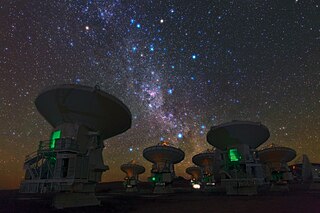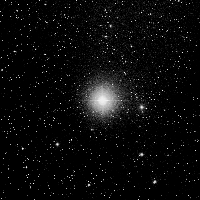In observational astronomy, a double star or visual double is a pair of stars that appear close to each other as viewed from Earth, especially with the aid of optical telescopes.

Albert Abraham Michelson FFRS HFRSE was an American physicist known for his work on measuring the speed of light and especially for the Michelson–Morley experiment. In 1907 he received the Nobel Prize in Physics, becoming the first American to win the Nobel Prize in a science.

Very-long-baseline interferometry (VLBI) is a type of astronomical interferometry used in radio astronomy. In VLBI a signal from an astronomical radio source, such as a quasar, is collected at multiple radio telescopes on Earth. The distance between the radio telescopes is then calculated using the time difference between the arrivals of the radio signal at different telescopes. This allows observations of an object that are made simultaneously by many radio telescopes to be combined, emulating a telescope with a size equal to the maximum separation between the telescopes.

The Navy Precision Optical Interferometer (NPOI) is an American astronomical interferometer, with the world's largest baselines, operated by the Naval Observatory Flagstaff Station (NOFS) in collaboration with the Naval Research Laboratory (NRL) and Lowell Observatory. The NPOI primarily produces space imagery and astrometry, the latter a major component required for the safe position and navigation of all manner of vehicles for the DoD. The facility is located at Lowell's Anderson Mesa Station on Anderson Mesa about 25 kilometers (16 mi) southeast of Flagstaff, Arizona (US). Until November 2011, the facility was known as the Navy Prototype Optical Interferometer (NPOI). Subsequently, the instrument was temporarily renamed the Navy Optical Interferometer, and now permanently, the Kenneth J. Johnston Navy Precision Optical Interferometer (NPOI) – reflecting both the operational maturity of the facility, and paying tribute to its principal driver and retired founder, Kenneth J. Johnston.

The Submillimeter Array (SMA) consists of eight 6-meter (20 ft) diameter radio telescopes arranged as an interferometer for submillimeter wavelength observations. It is the first purpose-built submillimeter interferometer, constructed after successful interferometry experiments using the pre-existing 15-meter (49 ft) James Clerk Maxwell Telescope and 10.4-meter (34.1 ft) Caltech Submillimeter Observatory as an interferometer. All three of these observatories are located at Mauna Kea Observatory on Mauna Kea, Hawaii, and can be operated together as a ten element interferometer in the 230 and 345 GHz bands. The baseline lengths presently in use range from 16 to 508 meters, and up to 783 meters (2,569 ft) for eSMA operations. The radio frequencies accessible to this telescope range from 180–418 gigahertz (1.666–0.717 mm) which includes rotational transitions of dozens of molecular species as well as continuum emission from interstellar dust grains. Although the array is capable of operating both day and night, most of the observations take place at nighttime when the atmospheric phase stability is best.
An intensity interferometer is the name given to devices that use the Hanbury Brown and Twiss effect. In astronomy, the most common use of such an astronomical interferometer is to determine the apparent angular diameter of a radio source or star. If the distance to the object can then be determined by parallax or some other method, the physical diameter of the star can then be inferred. An example of an optical intensity interferometer is the Narrabri Stellar Intensity Interferometer. In quantum optics, some devices which take advantage of correlation and anti-correlation effects in beams of photons might be said to be intensity interferometers, although the term is usually reserved for observatories.

Delta Andromedae is a multiple star system in the northern constellation of Andromeda. Based upon parallax measurements, it is located at a distance of approximately 105.5 light-years from the Earth.

Eta Andromedae is a spectroscopic binary star in the constellation of Andromeda. It consists of two G-type subgiant or giant stars orbiting each other with a period of 115.7 days and has an overall apparent visual magnitude of approximately 4.403.

Phi Aquarii is the Bayer designation for a binary star system in the equatorial constellation of Aquarius. It is visible to the naked eye with an apparent visual magnitude of +4.223. Parallax measurements from the Hipparcos mission indicate its estimated distance from Earth is roughly 220 light-years.

Alpha Camelopardalis is a star in the constellation Camelopardalis, with an apparent visual magnitude of 4.3. It is the third-brightest star in this not-very-prominent circumpolar constellation, the first and second-brightest stars being β Camelopardalis and CS Camelopardalis, respectively. It is the farthest constellational star, with a distance of 6,000 light-years from Earth.

The United States Naval Observatory Flagstaff Station (NOFS), is an astronomical observatory near Flagstaff, Arizona, USA. It is the national dark-sky observing facility under the United States Naval Observatory (USNO). NOFS and USNO combine as the Celestial Reference Frame manager for the U.S. Secretary of Defense.

The Magdalena Ridge Observatory (MRO) is an astronomical observatory in Socorro County, New Mexico, about 32 kilometers (20 mi) west of the town of Socorro. The observatory is located in the Magdalena Mountains near the summit of South Baldy Mountain, adjacent to the Langmuir Laboratory for Atmospheric Research. Currently operational at the site is a 2.4-meter fast-tracking optical telescope, and under construction is a ten-element optical interferometer.
In optical astronomy, interferometry is used to combine signals from two or more telescopes to obtain measurements with higher resolution than could be obtained with either telescopes individually. This technique is the basis for astronomical interferometer arrays, which can make measurements of very small astronomical objects if the telescopes are spread out over a wide area. If a large number of telescopes are used a picture can be produced which has resolution similar to a single telescope with the diameter of the combined spread of telescopes. These include radio telescope arrays such as VLA, VLBI, SMA, LOFAR and SKA, and more recently astronomical optical interferometer arrays such as COAST, NPOI and IOTA, resulting in the highest resolution optical images ever achieved in astronomy. The VLT Interferometer is expected to produce its first images using aperture synthesis soon, followed by other interferometers such as the CHARA array and the Magdalena Ridge Observatory Interferometer which may consist of up to 10 optical telescopes. If outrigger telescopes are built at the Keck Interferometer, it will also become capable of interferometric imaging.
HD 118889 is a binary star in the northern constellation of Boötes.
HD 131473 is a binary star system in the northern constellation of Boötes. The primary is an F-type subgiant with a stellar classification of F4IV, while its companion is a G-type subgiant with a stellar classification of G1IV.

Gerard Theodore van Belle is an American astronomer. He received a bachelor's degree in physics from Whitman College in 1990, a master's in physics from The Johns Hopkins University in 1993, and a Ph.D. in physics from the University of Wyoming in 1996. While at Whitman College, he initiated as a member of the Sigma Chi fraternity.

Tau Persei, also known as 18 Persei, is a binary star in the constellation of Perseus. The system is fairly close, and is located about 254 light-years away, based on its parallax.
















